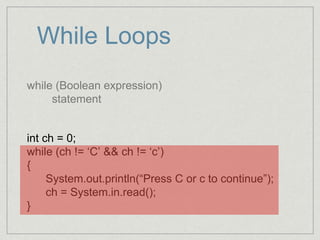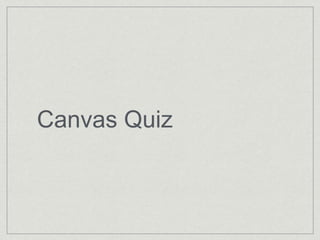Ad
Java 2
- 2. What you we learn Should learn the basics of the Java language All Java language needed for Android development Object-oriented software basics
- 3. What is Java? Java is a language and a platform originated by Sun Microsystems. Java’s syntax is partly patterned after the C and C++ languages Help shorten the learning curve.
- 4. Classes Object-oriented applications represent entities as objects. Each object encapsulates an entity’s attributes and behaviors. Objects do not pop out of thin air; they must be instantiated (created) from something. Languages such as C++ and Java refer to this “something” as a class.
- 5. Declaring a Class Declares a class named CheckingAccount. By convention, a class’s name begins with an uppercase letter. class CheckingAccount { // fields // methods // other declarations }
- 6. Fields After declaring a class, you can declare variables in the class’s body. Entity attributes Class attributes
- 7. Declaring Fields Declares two fields name owner and balance. By convention, a field’s name begins with a lowercase letter class CheckingAccount { String owner; int balance; int theCounter; } TYPE NAME
- 8. Java Primitive Types Primitive Type Reserved Size Min Max Boolean boolean -- -- -- Character char 16 bit Byte Integer byte 8-bit -128 127 Short Integer short 16-bit -2^15 2^15 -1 Integer int 32-bit -2^31 2^31 -1 Long Integer long 64-bit -2^63 2^63 - 1 Floating-point float 32-bit IEEE 754 IEEE 754 Double Precision floating-point double 64-bit IEEE 754 IEEE 754
- 9. Arrays a multi-value variable each element holds one value. ex. of array based field class WeatherData { String country; String[ ] cities; double[ ] [ ] temp; } ARRAY TYPE
- 10. Static Fields counter is a class field. a field associates with a class instead of the class’s object. one object associate with all created class of the same type class CheckingAccount { String owner; int balance; static int counter; } KEYWORD
- 11. Initializing Fields Is it common to initialize an instance field to a value. fields are initialized to default values when the object is created. String = “”; int = 0; objects = null;
- 12. Example class WeatherData { String country = “United States”; String[ ] cities = {“Chicago”, “New York”}; double[ ] [ ] temperatures = {{0.0, 0.0}, {0.0, 0.0}}; }
- 13. Expressions & Operators Operator Symbol Addition + Array Index [ ] Assignment = Bitwise & Bitwise complement ~ Bitwise exclusive OR ^ Bitwise inclusive OR | Cast ( type ) Compound assignment +=, -=, *=, /=, %=, &=, |=, ^=, <<=, >>=, >>>=
- 14. Expressions & Operators Continued... Operator Symbol Conditional ?: Conditional AND && Conditional OR || Division / Equality “==” Inequality != Left shift << Logical AND & Logical complement ! Logical exclusive OR ^
- 15. Expressions & Operators Continued... Operator Symbol Logical inclusive OR | Member access . Method call ( ) Multiplication * Object creation new Decrement -- Increment ++ Relational greater than > Relational greater than equal to >=
- 16. Expressions & Operators Continued... Operator Symbol Relational less than < Relational less than equal to <= Relational type checking instanceof Remainder % Signed right shift >> String concatenation + Subtraction - Unary minus - Unary plus + Unsigned right shift >>>
- 17. Casting Casting is used to convert one type to another. Only certain types can be casted to another type. char c = ‘A’; // incorrect way byte b = c; // correct way byte b = (byte) c; CAST
- 18. Read-only Fields final keyword final used for fields that are read-only. this field must be initialized in the constructor or field’s declaration. constant can be accomplished by using static with final. class Employee { final int AGE = 26; // constant ex. final static int RETIRE_AGE = 65; }
- 19. Declaring Methods Declare methods within a class’s body. Should return a type. followed by an identifier that names the method. followed by a parameter list. followed by a body. class CheckingAccount { String owner; int balance; static int counter; void printBalance() { // function } }
- 20. Implementing Methods void printBalance() { int magnitude = (balance < 0) ? -balance : balance; String balanceRep = (balance < 0) ? “(“ : “”; balanceRep += magnitude; balanceRep += (balance < 0) ? “)” : “”; System.out.println(balanceRep); }
- 21. Decisions & Loops if statement switch statement for loops while loops do while loops break and continue
- 22. If statements void printBalance() { if (balance < 0) System.out.println(balance); else if (balance == 0) System.out.println(“zero balance”); else System.out.println(balance * balance); }
- 23. Switch Statement switch (selector expression) { case value1: statement1 [break;] case value2: statement2 [break;] case valueN: statementN [break;] [default: statement] } int balance = 5; switch(balance) { case 1: balance = 42; break; case 2: balance = 43; break; default: balance = 99; }
- 24. For Loops for ([ initialize ]; [ test ]; [ update ]) statement; public static void doSomething(int size) { for (int i = 0; i < size; i++) { // inside the for loop } }
- 25. While Loops while (Boolean expression) statement int ch = 0; while (ch != ‘C’ && ch != ‘c’) { System.out.println(“Press C or c to continue”); ch = System.in.read(); }
- 26. Do While Loops do statement while(Boolean expression); int ch; do { System.out.println(“Press C or c to continue”); } while (ch != ‘C’ && ch != ‘c’);
- 27. Break and Continue break continue break outer continue outer
- 28. Constructors Constructors are named blocks of code, declared in class bodies for constructing objects by initializing their instance fields and other developer needs. class CheckingAccount { String owner; int balance; // Constructor start CheckingAccount(String acctOwner, int acctBalance) { owner = acctOwner; balance = acctBalance; } }
- 29. Access Control Public A field, method, or constructor that is accessible from anywhere. A source file can only contain one public class per source file. Protected A field, method, or constructor that is accessible from all classes in of subclasses. Private A field, method, or constructor that is can not be accessed beyond the class in which it is declared. Package-private ?
- 30. Example of Access public class Employee { private String name; public Employee(String name) { setName(name); } public void setName(string empName) { name = empName; } }
- 31. Creating Objects and Arrays Employee emp = new Employee(“John”, “Doe”); OBJECT TYPE CREATE MEMORY SPACE AND RETURN OBJECT’S REFERENCE CONSTRUCTOR
- 32. Accessing Fields // Create object Account account = new Account(23423); // Call the field int id = account.customerId; // id contains the number 23423 PUBLIC FIELD
- 33. Calling Methods // Create object Account account = new Account(23423); // Call the method int id = account.getCustomerId(); // id = 23423 // set the id to 87873 account.setCustomerId(87873); id = account.getCustomerId(); // id = 87873 PUBLIC METHOD PUBLIC METHOD
- 34. Chained Instance Method Calls Account myAccount = new Account(9723); // multiple method calls myAccount.deposit(1000).printBalance(); PUBLIC METHOD #1PUBLIC METHOD #2
- 35. Garbage Collections Objects are created via reserved word new how are they destroyed? Garbage collector is code that runs in the background and checks for unreferenced objects. When it discovers an unreferenced object, the garbage collector removes it from the heap (memory)
- 36. Garbage Collector++ // referenced object Account myAcc = new Account(9734); // unreferenced object myAcc = null;
- 37. Inheritance or Extending public abstract class Animal { public abstract void eat(); } public class Bird extends Animal { @Override public final void eat() { } }
- 38. Inheritance Method Override public abstract class Animal { public abstract void eat(); } public class Bird extends Animal { @Override public final void eat() { } }
- 39. Runtime Type Identification public class A { // stuff } void main( ) { int h = 0; A obj = new A( ); if ( ( h instanceof A) || ( obj instanceof A ) ) { // Do something } }
- 40. Interfaces Interfaces are like contracts An agreement between two class or parties that says these methods and properties are to be in both classes and will not change. Good for two classes that have nothing in common to have common methods and properties.
- 41. Implementing Interfaces public interface ICountable { int getCount(); } public abstract class Animal implements ICountable { @Override public final int getCount() { return 1; } }
- 42. Extending Interfaces interface IDrawable { void draw(int color); } interface Fillable extends IDrawable { void fill(int color); }
- 43. Anonymous Classes abstract class Speaker { abstract void speak(); } public class ACDemo { public ACDemo() { new Speaker() { void speak() { System.out.println(“Hello”); } } .speak(); } }
- 44. Local Classes public class EnclosingClass { public void m (final int x) { final int y = x*2; class LocalClass { int a = x; int b = y; } } }
- 45. Packages Packages are the same as namespaces in C++ A package is a unique namespace that can contain a combination of top-level class, types, and sub- packages. Package name must be unique
- 46. Importing import is the same as #include in C++ Includes a package to use with the current file. Uses the import keyword
- 47. Exceptions try { // try some code here. } catch ( SomeException ex ) { }
- 49. ArrayList // Create new ArrayList ArrayList<String> listOfStuff = new ArrayList<String>(); // Add items to list listOfStuff.add(“NewString”); // Get item String s = list.get(0);
- 50. Enumerations public class Weekday { public final static int SUNDAY = 0; public final static int MONDAY = 1; .... } public enum Coin { PENNY, NICKEL, DIME, QUARTER }
- 51. Canvas Quiz









![Arrays
a multi-value variable
each element holds
one value.
ex. of array based field
class WeatherData
{
String country;
String[ ] cities;
double[ ] [ ] temp;
}
ARRAY TYPE](https://image.slidesharecdn.com/8eiie4lcsvweufchnj0i-signature-55e8d63eea27c6fc2d1657acf7cc783e72e866b220d2e16aeb4912c683ae8ee7-poli-150719231810-lva1-app6891/85/Java-2-9-320.jpg)


![Example
class WeatherData
{
String country = “United States”;
String[ ] cities = {“Chicago”, “New York”};
double[ ] [ ] temperatures = {{0.0, 0.0}, {0.0, 0.0}};
}](https://image.slidesharecdn.com/8eiie4lcsvweufchnj0i-signature-55e8d63eea27c6fc2d1657acf7cc783e72e866b220d2e16aeb4912c683ae8ee7-poli-150719231810-lva1-app6891/85/Java-2-12-320.jpg)
![Expressions &
Operators
Operator Symbol
Addition +
Array Index [ ]
Assignment =
Bitwise &
Bitwise complement ~
Bitwise exclusive OR ^
Bitwise inclusive OR |
Cast ( type )
Compound assignment
+=, -=, *=, /=, %=, &=, |=, ^=,
<<=, >>=, >>>=](https://image.slidesharecdn.com/8eiie4lcsvweufchnj0i-signature-55e8d63eea27c6fc2d1657acf7cc783e72e866b220d2e16aeb4912c683ae8ee7-poli-150719231810-lva1-app6891/85/Java-2-13-320.jpg)









![Switch Statement
switch (selector expression)
{
case value1: statement1 [break;]
case value2: statement2 [break;]
case valueN: statementN [break;]
[default: statement]
}
int balance = 5;
switch(balance)
{
case 1: balance = 42; break;
case 2: balance = 43; break;
default: balance = 99;
}](https://image.slidesharecdn.com/8eiie4lcsvweufchnj0i-signature-55e8d63eea27c6fc2d1657acf7cc783e72e866b220d2e16aeb4912c683ae8ee7-poli-150719231810-lva1-app6891/85/Java-2-23-320.jpg)
![For Loops
for ([ initialize ]; [ test ]; [ update ])
statement;
public static void doSomething(int size)
{
for (int i = 0; i < size; i++)
{
// inside the for loop
}
}](https://image.slidesharecdn.com/8eiie4lcsvweufchnj0i-signature-55e8d63eea27c6fc2d1657acf7cc783e72e866b220d2e16aeb4912c683ae8ee7-poli-150719231810-lva1-app6891/85/Java-2-24-320.jpg)































































































